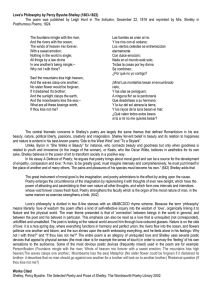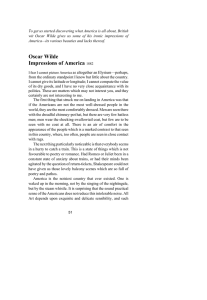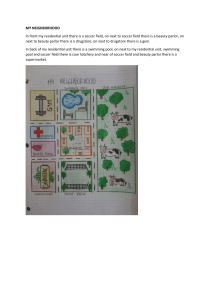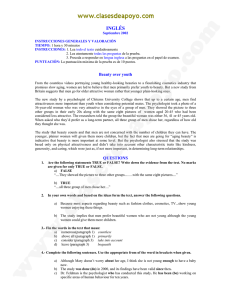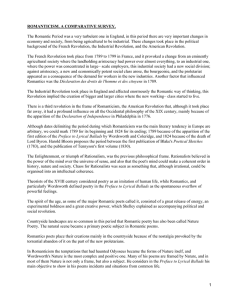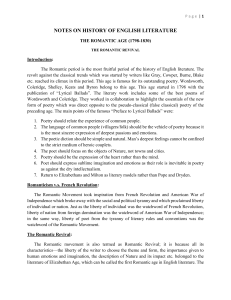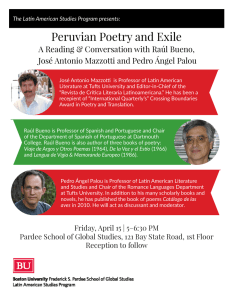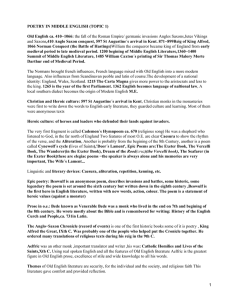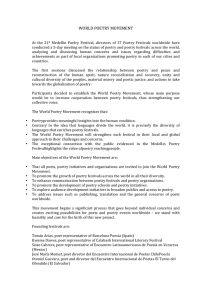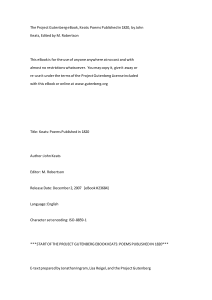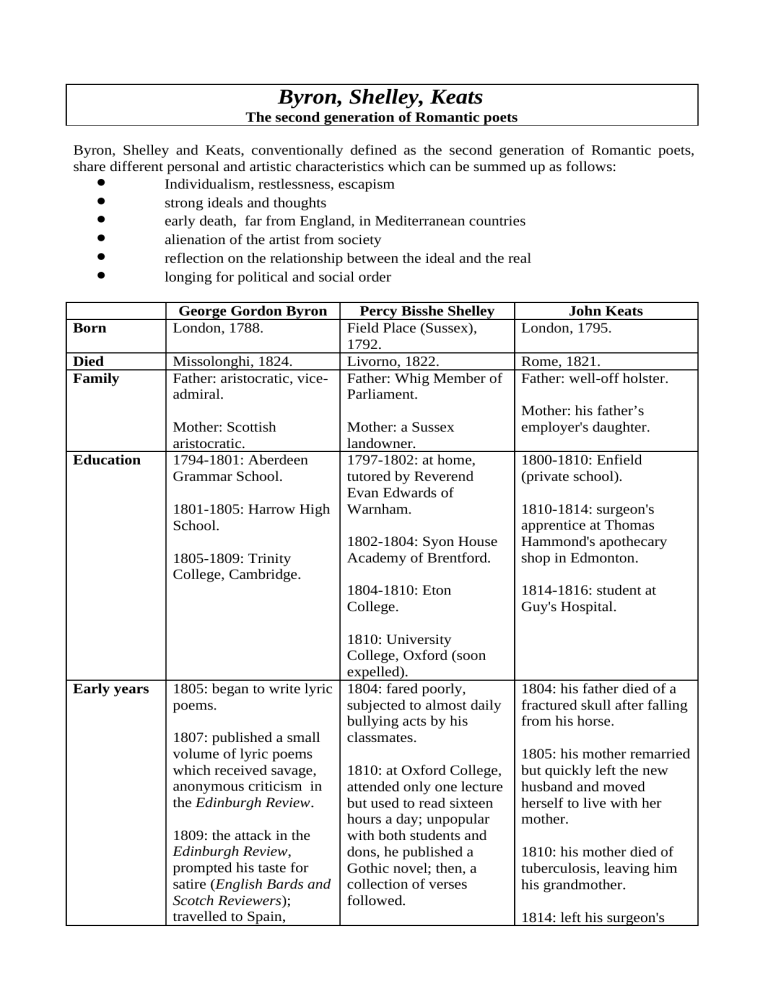
Byron, Shelley, Keats The second generation of Romantic poets Byron, Shelley and Keats, conventionally defined as the second generation of Romantic poets, share different personal and artistic characteristics which can be summed up as follows: Individualism, restlessness, escapism strong ideals and thoughts early death, far from England, in Mediterranean countries alienation of the artist from society reflection on the relationship between the ideal and the real longing for political and social order Born Died Family Education George Gordon Byron London, 1788. Missolonghi, 1824. Father: aristocratic, viceadmiral. Mother: Scottish aristocratic. 1794-1801: Aberdeen Grammar School. 1801-1805: Harrow High School. 1805-1809: Trinity College, Cambridge. Early years Percy Bisshe Shelley Field Place (Sussex), 1792. Livorno, 1822. Father: Whig Member of Parliament. Mother: a Sussex landowner. 1797-1802: at home, tutored by Reverend Evan Edwards of Warnham. John Keats London, 1795. Rome, 1821. Father: well-off holster. Mother: his father’s employer's daughter. 1800-1810: Enfield (private school). 1802-1804: Syon House Academy of Brentford. 1810-1814: surgeon's apprentice at Thomas Hammond's apothecary shop in Edmonton. 1804-1810: Eton College. 1814-1816: student at Guy's Hospital. 1810: University College, Oxford (soon expelled). 1805: began to write lyric 1804: fared poorly, poems. subjected to almost daily bullying acts by his 1807: published a small classmates. volume of lyric poems which received savage, 1810: at Oxford College, anonymous criticism in attended only one lecture the Edinburgh Review. but used to read sixteen hours a day; unpopular 1809: the attack in the with both students and Edinburgh Review, dons, he published a prompted his taste for Gothic novel; then, a satire (English Bards and collection of verses Scotch Reviewers); followed. travelled to Spain, 1804: his father died of a fractured skull after falling from his horse. 1805: his mother remarried but quickly left the new husband and moved herself to live with her mother. 1810: his mother died of tuberculosis, leaving him his grandmother. 1814: left his surgeon's Portugal, Malta, Albania, Greece and the Middle East. 1812: published Childe Harold’s Pilgrimage and became a literary and social celebrity. 1815: got married but his marriage collapsed because of his incestuous love with his half-sister. 1816: left England. 1811: published a pamphlet (The Necessity of Atheism) for which he was expelled from Oxford; then, got married (Harriet) and had a child. 1814: abandoned his pregnant wife and child and sailed to Europe, bound for Switzerland; after six weeks, homesick and destitute, returned to England. 1815: lived close to London avoiding creditors. 1816: on a second trip to Switzerland, met Byron; regular conversation with him had an invigorating effect on his output of poetry got married for the second time (Mary). 1817: met Keats. Late years 1816: lived in Geneva where met P. B. Shelley. 1817: moved to Venice. 1819: moved to Milan where became involved in the patriotic plots against Austrian rule. 1820: joined ‘carboneria’, the Italy’s revolutionary organization 1823: decided to commit himself to the Greek struggle of independence from Turkey. 1824: organized an 1818: left England. 1818: lived in Venice, Naples and Florence. 1819: lived in Rome where he wrote political poems and essays. 1820: lived in Pisa; heard of John Keats' illness and wrote him a letter inviting him to join him; Keats replied with hopes of seeing him, but instead, arrangements were made for Keats to travel to Rome. 1821: inspired by the death of Keats, wrote an elegy. apprenticeship after a fight with his master at Thomas Hammond's apothecary and became a student at Guy's Hospital; devoted more and more of his time to the study of literature. 1817: met Shelley. 1818. fell in love with Fanny Brawne; got married but poverty, bad health and pursuit of poetry made marriage impossible. 1819: spent a week in the Isle of Wight ; then, stayed in Winchester where he wrote The Eve of St Agnes. 1820: cut his relationship with his wife; began showing serious signs of tuberculosis and decided to leave the cold airs of London behind; left England. 1820: lived in Rome where, despite attentive care of his friends, his health rapidly deteriorated. 1821: died; buried in the Protestant Cemetery, Rome; his last request was to be buried under a tombstone reading, "Here lies One Whose Name was writ in Water." His name was not to appear on the stone. Despite these requests, however, his friends also added the epitaph: "This Grave contains all that was mortal, of a YOUNG ENGLISH POET, who on expedition and devoted himself to training the troops in Missolonghi where he died struck by a severe fever; his heart is buried in Greece, his body in England. Main works Ideals & thought Childe Harlod’s Pilgrimage (1812-1818), The Corsair (1814), Don Juan (1819-1824). believed in individual freedom and hated any form of constraint; denounced the evils of society and fought against tyrants. Political commitment joined ‘carboneria’; decided to commit himself to the Greek struggle of independence from Turkey; organized an expedition and devoted himself to training the troops in Missolonghi. Role of imagination more than being the result of imagination, “poetry is the expression of excited passion, and that there is no such thing as a life of passion any more than a continuous earthquake, 1822: was setting up a journal which would act as a counter-blast to conservative periodicals; drowned in a sudden storm while sailing back from Livorno to Lerici in his schooner; his body was cremated and his heart was snatched from the funeral pyre and given to Mary Shelley who kept it. Ode to the West Wind (1819), To a Skylark (1820), Prometheus Unbound (1820). contempted conventional forms of religion and polotics; refused all social conventions, political oppression and any form of tyranny; believed in a better future in which to apply the principle of freedom and love through which man could overcome any political, moral and social constraint. his political commitment appears in a series of angry political poems condemning the arrogance of the power; his political poetry has less to do with his intervention in contemporary politics (The Masque of Anarchy, Men of England, England in 1819). imagination is expressed through poetry which contains revolutionary creativity meant to change the reality (stronger than the ideal) of an increasingly material world. his Death Bed, in the Bitterness of his heart, at the Malicious Power of his enemies, desired these words to be Engraven on his Tomb Stone" along with the image of a lyre with broken strings. Ode on a Grecian Urn (1819), The Eve of St Agnes (1819), La Belle Dame sans Merci (1819). his imagination is stricken by beauty and his disinterested love for it; the contemplation of beauty is fundamental to reach truth which is the ideal of all art; the Classical Greek art is expression of beauty (and so that truth) which lives again re-interpreted with the eyes of a Romantic poet. though there is no evidence of his active political involvement in the events of the period, his socio-political consciousness is reflected in his works where nature (in connection with the glorification of classical Greek art) is seen as a symbolic representation of the ideas of liberty, peace, and freedom. imagination has a supreme twofold value: a) in his poetry he imagines a predominantly artificial world; b) poetry comes from imagination in the sense that a great deal of his work is a vision of Poet’s task View of nature or an eternal fever” (letter to his friend Thomas Moore, 5 July 1821). never considered himself a Romantic poet; he embodied a passionate, moody, restless and mysterious man who hid some horrible sin or secret in his past; proud individualist, rejected the conventional moral rules of society; outsider, isolated and attractive at the same time; noble of birth, but rough and wild in his manners; hard but handsome, with great sensibility to nature and beauty; bored with the excesses and excitments of the world; women could not resist him, but he refused their love; men either admired or envy him (Byronic hero). nature is seen as wild, cruel and exotic, and provides a foreground landscape for an isolated man; it is not a source of consolation and joy. what he would like human life to be; imagination should be struck by beauty which is the ideal of all art. a poet had to be both a The poet is endowed with prophet and a Titan the ability to experience challenging the cosmos; ‘uncertainties, mysteries, his task was to help doubts without any mankind to reach an ideal irritable reaching after fact world where freedom, and reason’. In other love and beauty win on words, the poet has the tyranny, destruction, capability to deny his alienation. certainties and personality in order to identify himself with the object which is the source of his inspiration and the place where Truth resides. When the poet can rely on this ability to deny (negative capability), he is able to seek sensation which is the basis of the knowledge since it leads to beauty and truth. Poetry is nothing else than the means through which beauty and truth are rendered. nature is a beautiful veil nature is purely that hides the eternal synaesthetically sensous truth of the Divine spirit; and the poet loves it for its it provides images (the own sake; it is percieved wind, the clouds...) and not only through the symbols for the creation noblest senses (sight and of cosmic schemes; it hearing), but through all represents the favourite the senses which lead to refuge from the reach ‘physical beauty’ disappointment and (that is colours, perfumes, injustice of the ordinary shapes...); if all senses are world and a hope for a involved in this process, better world. joy is much deeper and ‘spiritual beauty’ is reached (that is love, friendship and poetry); ‘physical beauty’ and ‘spiritual beauty’are strictly interwoven since the former is linked to life, enjoyment, decay and death and the latter is related to eternity. Style witty, satirical; sometimes seems to descend from neoclassical models rather than earlier Romantic poets. it covers a wide range of metric and stanzaic forms: from the Spenserian stanza to the couplet, from the blank verse to Dante’s terza rima, from the political ballad to the classical elegy and the short lyric poetry. His lyric “I” is not spiritually autobiographic, does not stand for a human being linked to the events of his time, but for a universal “I”;
